Spring: A Manic Time in the Garden
The Season’s Ups and Downs
To me, spring can be a manic time of year. On the one hand, no tree is more beautiful or festive than a peach tree loaded with pink blossoms. I’d say almost the same for apples, pears, and plums, their branches laden with clusters of white blossoms.
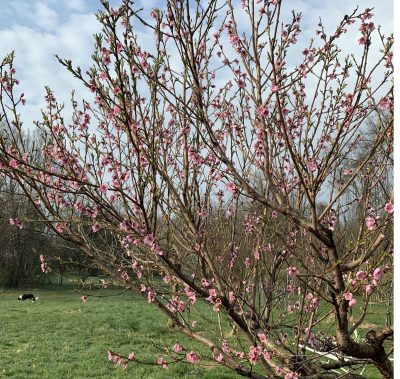
And it’s such a hopeful season. If all goes well, those blossoms will morph, in coming months, into such delicacies as Hudson’s Golden Gem and Pitmaston Pineapple apples, and Magness, Seckel, and Concorde pears. My peach tree was grown from seed, so has no name. With all this beauty and anticipation, I can periodically forget the pandemic that’s raging beyond my little world here.
But even as my eyes feast on the scene and I forget about the pandemic, I can’t forget about the weather’s ups and downs. Specifically, the temperature: Frosty weather has the potential to turn blossoms to mush and ruin the chances for fruit. Especially on my farmden, here in the Wallkill River valley. As in other low-lying locations, on clear, cold nights, a temperature inversion occurs, with heat radiated to the clear sky making ground level temperatures low. Cold air is denser than warmer air, so all the cold air flows down slopes to collect in valleys.
There’s not much to do to avert that frost damage. A blanket thrown over a tree would help but my trees are too large and too many. Branches could be sprayed with water; water, in transitioning to ice, releases its heat of fusion as long as it’s continuously applied. A helicopter or a “wind machine” could dilute colder air at ground level with warmer air from higher up. These methods might be used commercially but, to quote the sage of Newburgh (that’s another story), “That’s not gonna happen” here.
Therapy, a Plan
Rather than worrying myself into the manic phase of spring, I’m going to assess the damage and live with it. For starters, I need to know the temperature.
I have been using is a nifty little device called Sensorpush, a 1-inch square cube, perhaps a half-inch thick, that I have mounted outside and that continually transmits the temperature to my cell phone.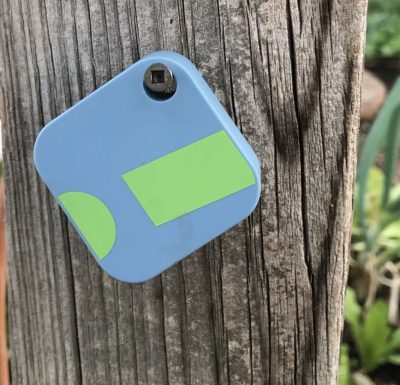 Great. Even better, temperature (as well as humidity) is recorded, and can be displayed graphically or downloaded to my computer. So I didn’t have to be awake to find out the mercury hit 32.5°F at 12:16 AM on the night of April 17th and stayed there until it began rising around 7 AM.
Great. Even better, temperature (as well as humidity) is recorded, and can be displayed graphically or downloaded to my computer. So I didn’t have to be awake to find out the mercury hit 32.5°F at 12:16 AM on the night of April 17th and stayed there until it began rising around 7 AM.
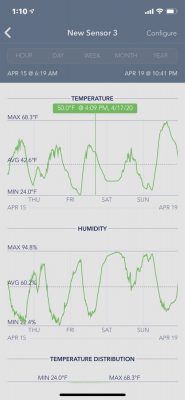
Fortunately, researchers have compiled temperatures at which damage to blossoms occurs. Specifically, damage enough to wipe 10% of the crop, and damage enough to wipe out 90% of the crop. And more specifically, applying those numbers to various kinds of fruits, which vary in their blossom’s cold tolerances. And even more specifically to the various stages of blossoming for each kind of fruit. Generally, less cold is required to kill a blossom the closer it is to bloom time.
Here is a chart compiled and photographed by Mark Longstroth of Michigan State University:

So now I can take this information, couple it with data recorded by Sensorpush, and foretell my sensory future, pomologically speaking. Below freezing temperatures since trees awakened have been 24° on April 17th, 27° on April 19th, and 26° on April 21st. Of course, it ain’t over till it’s over, and the average date of the last frost here is about mid-May.
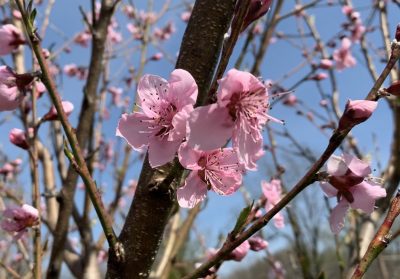
Peach bloom
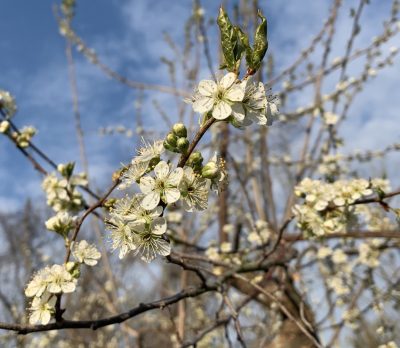
Plum blossoms
My plum trees were in full bloom on April 13th, at which time the blossoms are susceptible to 10% kill at 28° and 90% kill at 23°. That makes only 10% loss. The peach tree was also in bloom on that date, and is very similar in it’s blossom’s cold tolerance, so only 10% loss there also, so far.
Asian pears were showing “first white” and “full white” on April 19th, when the low hit 27°. That temperature would cause them no damage. The same would be true, going forward, for subsequent temperatures above 27°. The Europeans should be fine because today, April 21st, they are in tight cluster, and cold hardy to 24°.
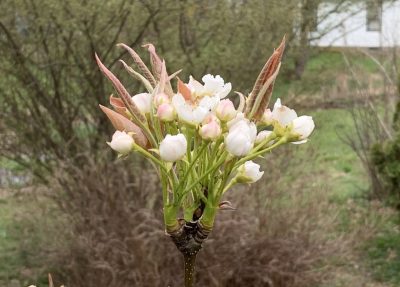
Asian pear full white
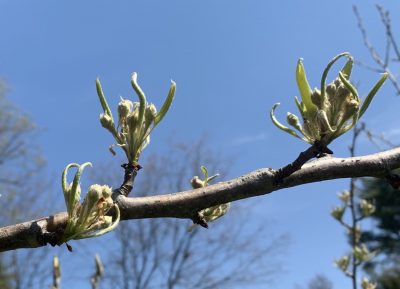
European pear tight cluster
Apples also are fine, also in tight cluster so, according to the chart, undamaged by temperatures above 27°.

Apple blossom tight cluster
And a Sprinkle of the Unknown
All this seems very science-y comforting, and it is. As with most garden science, though, things are more complicated, to some extent, than can be easily predicted. For one thing, some variation in cold hardiness undoubtedly exists from one variety to the next. In the case of my trees, I have an American hybrid and some European hybrid plums; they might more generally differ in blossom hardiness. And what about the length of time at a given temperature, and the effect of humidity?
Overall, the chart has calmed me down. Not to mention that a certain amount of fruit loss would be a good thing. A tree has just so much energy, and too big a crop makes for less flavor and size. Only 5% of blossoms of an apple tree need to set fruit for a full crop.
Now, I can move on to worry about insect and diseases that might hone in on my fruit.


I have an apple espalier and a yellow egg plum tree. A low of 28 degrees in CT tonight but looking at your chart they should be ok. Thanks for the timely information
Heard you on an older Joe Lamp’l podcast and couldn’t wait to come to your site. I love it! And this was a very enjoyable post and I can’t wait to read more. Thanks!!
Thank YOU!
Are espaliered apple trees (esp those that are young) more susceptible to temps like these in April zone 5? I just purchased one so wondering if i should bring in or just plant outside and cross fingers? thanks!
Espalier should be the same hardiness as a non-espalier of the same variety and rootstock.
Hello, and thanks so much for posting those images. Lovely to see. I am up in Maine in zone 5B and my plums buds are really swelling. Apples less so but the cherries buds are swelling enough to easily distinguish fruiting buds. I have a greenhouse, and I had lots of seedlings chugging along, including Roselle. I stopped covering them inside the greenhouse and they seemed fine but high winds last week snatched the 6 mil cap off the twin-wall roof and the bubble wrap beneath it as well. Then we had some frost. Interestingly, the peppers sailed through and most other things but the Roselles and the alliums got nipped. They were out in the greenhouse the same amount of time. What gives? The temperature swings and massive rains up here are wreaking havoc with my plants. I am wondering if I should cover the plums. It does seem that the fruit trees have their own instinctive behavior, as they were rapidly waking then when the weather changed they just stalled. Hoping the apricot survives as last year we had a late chill and I lost every fruitlet. Do you have a post where you recommend cultivars for apricot? I have a Moorpark self fertile on dwarf stock. It is 6 years old from a whip. Looks healthy.
I gave up on apricots — twice. Spring frost is always an issue with them. And then they are susceptible to swings in winter temperatures. And to insects and diseases. On the other hand, biting iinto a dead ripe apricot is heavenly.
That is all very interesting to know, even if I have no fruit trees. Here in normally mild mid-Ohio last week, it got down to 24 one night, and 20 the next. What it totally destroyed was every single blossom on my wisteria. Now, I have a love/hate relationship with my wisteria with it’s out of control growth, but this February, I did what Adam Frost of Gardeners’ World said to do, and that is prune it back to 2 buds per branch. I thought maybe it would not bloom at all since it looked significantly hacked back. I told myself I wouldn’t mind if it didn’t bloom, since it is so messy on the deck as the petals fall, and if the pods aren’t cut off, they shoot seeds everywhere in the fall. Well, to my surprise, it was laden with hundreds of blooms, more than it has ever had.
When they were all killed, I cried. Partly because of the anticipation of seeing such beauty, and partly the toll the quarantine is taking. It was a time of grieving many loses. It has been a cruel spring here in Ohio with a winter way too warm, and a spring way too cold. A lethal combination for many plants and blossoms.
Not to make you feel even worse, but since the blossoms were killed the palnt can now put even more energy into rampant growth this season!
Lee, My barefoot strawberries arrrived yesterday. I can’t plant them for another week when the bed will be finished. How do I keep them healthy? I could heel them inn a container until the bed is finished. Any advice would be appreciated. Thank you.
Heeling them in would work. Or, keep the roots wrapped in plastic and moist and put the plants in the refrigerator.
Thank you for this most useful blog post. We had frost to 27F here in NJ zone 6b, too, and I was worrying for my apple trees. I think they should be fine according to the table in your post.
A bit off topic, but I have a couple of questions regarding pawpaws and Nanking cherries. After listening to you singing the praises of both plants on one of Margaret Roach’s podcasts I ordered enough Nanking cherry whips to hopefully make a nice hedge along my driveway as well as two different kinds of pawpaws. The cherries are about 15-18″ tall and leafing out all along the stem. Would you advise me to leave them as they are or to cut them down a bit to encourage lower branches?
As for the pawpaws, I read in your book about unusual fruit that they must have shade while young but sun as they grow up. I don’t have a suitable situation for that and since I understand that they dislike transplanting, I’m a bit unsure how and where to plant them.
Hope you don’t mind this OT post 🙂
Stay healthy and sane!
Marianne
The Nanking cherries? Just let them grow.
The pawpaws? That shading only applies to pawpaw seedlings. If you bought a named variety, it was grafted. The scion is mature wood so does not need shading.
Thank you so much Lee!! This is super helpful. I can’t wait to taste both the cherries and the pawpaws. Wonder how long I have to wait… Gardening = Patience :-))
Two years ago I bought a plum tree at a native plant sale here in Atlanta, but all the branches on one side broke off in the delivery truck. I planted it anyway, and it has done well. The branches on the injured side are about 1 inch long and on the healthy side up to 30 inches long. The tree is 42 inches tall. Now, what…Prune it back hard next Winter? Leave it alone? Graft some other type of fruit branch on the bad side? What would you do?
I like to prune young trees as little as possible. Pruning stunts growth so limit it only to what is necessary. The tree should, over time, balance its growth. You could just check growth on the more vigorous side of the tee by pinching growing tips to let the smaller branches on the other side catch up. Make sure that the young tree does not have future main branches too close up along the trunk; they should be about 6″ apart when above lower tier. Remove any excess branches right to their bases.
For the past 2-3 years my peach trees habe barely blossomed, thus no fruit (I live in Iowa). I’m afraid to prune it back too much for fear that there will be nothing left as there are very few let leaves. Any advice? I should note that we had some construction 3 years ago as well but stayed away from the trees. Thank you!
Pruning back this spring would coax new growth that should bloom next spring. It’s hard to say what the problem is if everything’s the same as further in the past except for lack of bloom in the past 2-3 years. Also, what’s “very few let leaves.”
Advice greatly appreciated- Thank you!
Super helpful, thanks! We have a small orchard and did rig up a sprinkler system – although now I’m wondering if we did more harm than good… we will see! So heartbreaking to see incredibly abundant beautiful peach blooms now just brown and ugly…
I’ve found that chart helpful too – do you know if that means that percentage of damage for a whole night of a certain temp or for every half hour there is that much damage? Thanks!
Not damage every half hour. It’s more general. If night temperatures hit those lows, that’s the amount of damage. As I wrote, it’s not that exacting — variety of plant, duration of cold, humidity, etc. also come into play.
I decided to try growing cauliflower and broccoli in my elevated planter this year and bought some small plants. Things seem to be going well but suddenly both have
been eaten right to the stalks. Have seen a white butterfly visiting and suspect this
could be the cause. Should I just pull them out or can they possibly recover?
If the plants were large enough to have stored up some energy, they should grow back.